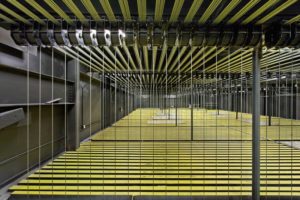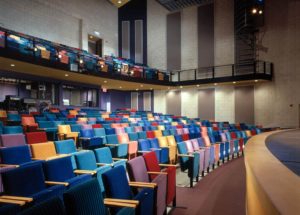Did You Know – Color My World
Did You Know (DYK) that a Black Box Theatre does not have to be black? It can easily be a deep, rich, warm, dark color such as a deep royal blue or a deep purple, or some other lovely, deep and dark color that absorbs more light than it reflects.
DYK that red upholstery on the audience seating, while being the most traditional, does not necessarily translate to more sophistication?
DYK that the stagehouse grid steel does not have to be black or dark gray? Grid steel is often now painted Safety Yellow or Orange.
DYK that the ceiling and walls of the control booth should be a dark matte color to avoid reflections of the console task lighting through the large glass control booth windows into the auditorium?
DYK that you should avoid recurring and swirling carpet patterns on stair runs, especially in the aisles, that can obscure stair edges and cause falls? Most jurisdictions require a contrasting nosing strip along all step edges.
DYK to avoid light-colored carpeting in heavily trafficked areas and, in particular, where red wine will be served? A maintenance nightmare!
DYK to avoid shiny brass or other reflective materials in the auditorium? These items may look nice when the house lights are up, but they can then become reflective and distracting to audience members under performance conditions.

The gridiron over a stage. The audience can’t see the grid, and the lighter color benefits technicians. Photo courtesy of Bill Conner, FASTC.
DYK that the stage interior walls in the upper reaches of the fly tower do not always need to be painted black? This zone is usually difficult to get work light into, so lighter toned walls can help with visibility, and this, in turn, can save money in initial construction and in long-term maintenance.
DYK that the Green Room does not have to be green? No one knows the exact origin of the term “Green Room”, although there are many theories (and another article.)
DYK that it is best to leave beige yellow (mustard) walls and red (catsup) accents for elementary school cafeterias and not in your nice, new auditorium?
DYK that theatre lighting and set designers often prefer that the architectural zone at the front of the auditorium and around the proscenium should transition to dark colors, and that architects often like to make that area light and pretty? Hmmm.
DYK that dressing rooms with make-up stations and costume shops where fabric is chosen and handled should have neutral colors on their walls so that performers and costumers can best judge how to simulate make-up and fabric under stage lighting conditions? The color temperature and color rendition of the lighting is also critical.
DYK that stage masking curtains should always be black? Only black. Always, always, always.

Multicolored or “Confetti” seating areas can look like there are more people in the audience even with lower occupancy. Photo courtesy of Schuler Shook.
DYK that the original Guthrie Theatre was a pioneer in randomly varying the colors of the audience seating in the iconic thrust stage auditorium designed by Tanya Moiseiwitsch and Ralph Rapson in 1963? This same concept was also used in the New Guthrie Theatre. This is often referred to as a “confetti” approach, and it helps make otherwise empty seating sections feel occupied.
DYK that every painted surface must be maintained – i.e., re-painted – on a regular basis?
By Robert Long, FASTC and Robert Shook, FASTC
Disclaimer: Any views or opinions expressed in this article are solely those of the author and do not necessarily represent those of the American Society of Theatre Consultants. This article is for general information only and should not be substituted for specific advice from a Theatre Consultant, Code Consultant, or Design Professional, and may not be suitable for all situations nor in all locations.


